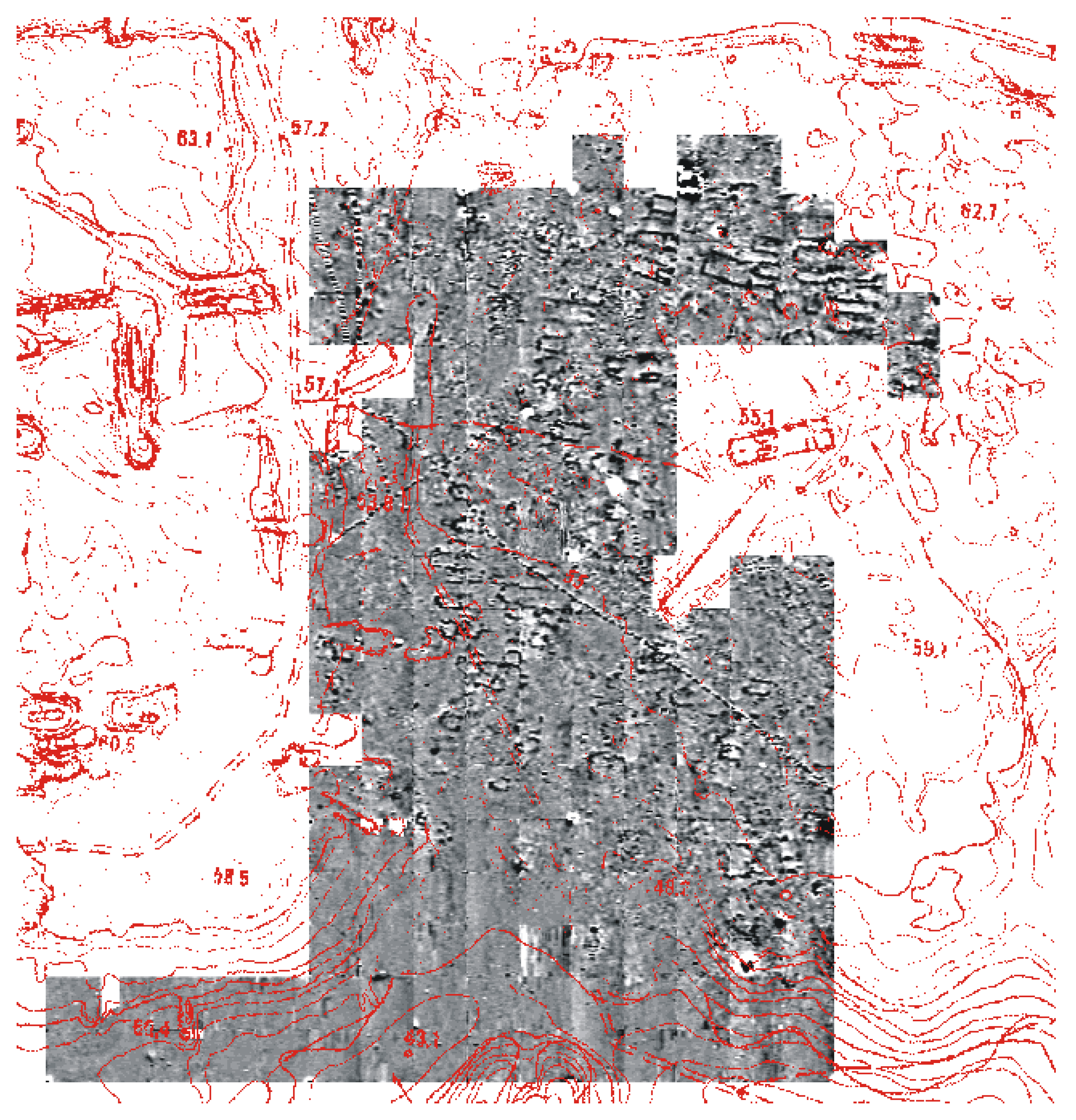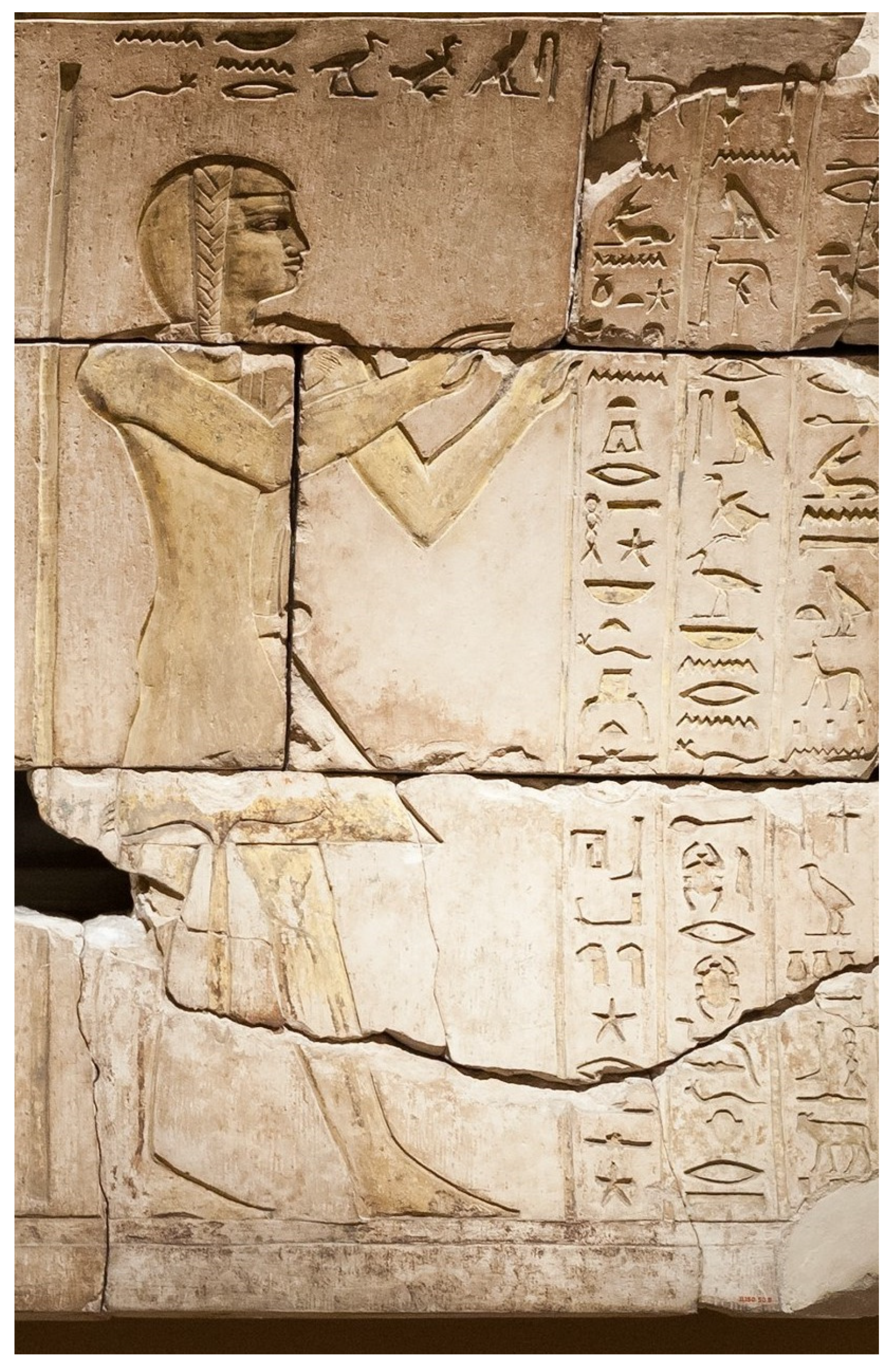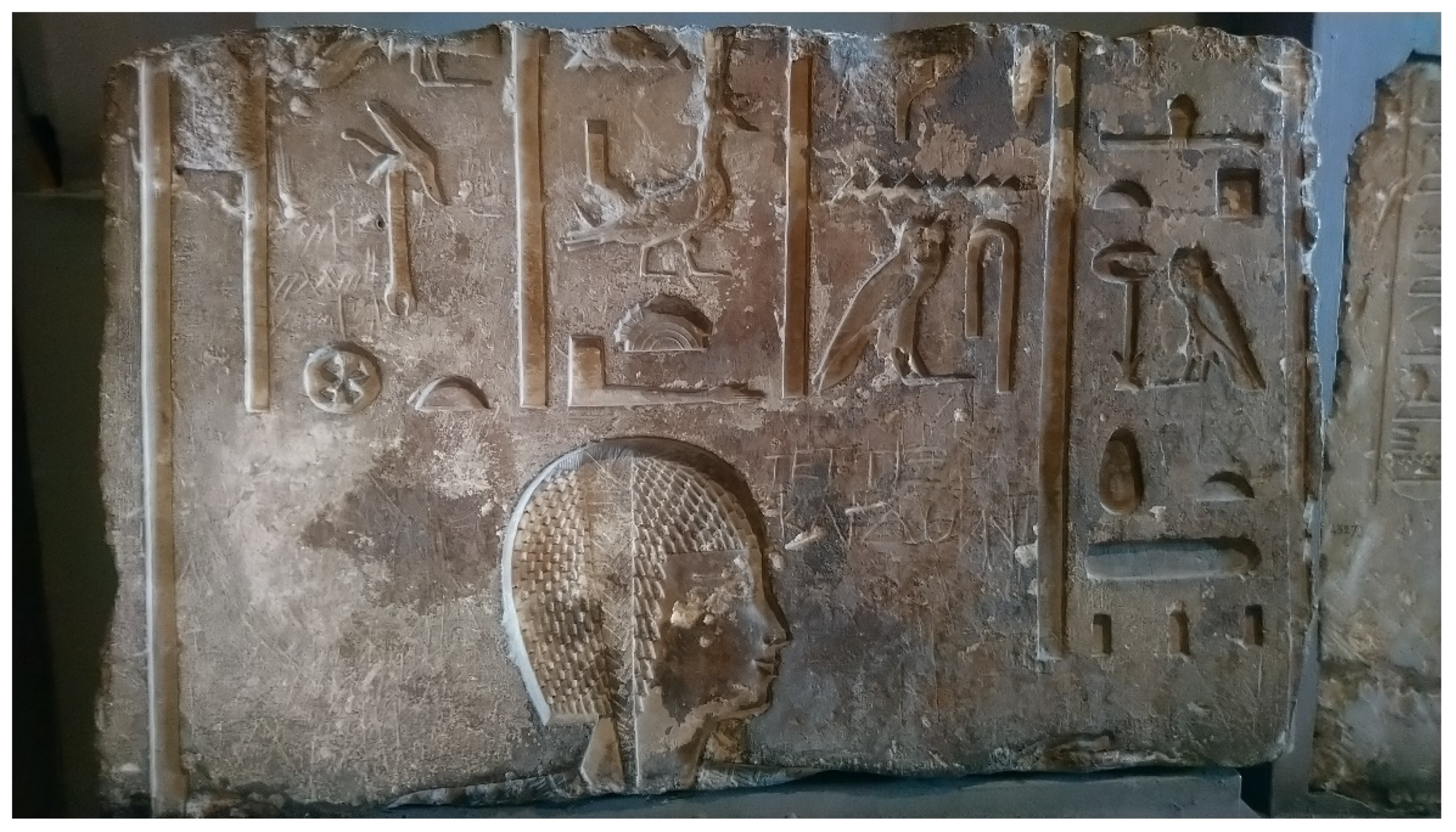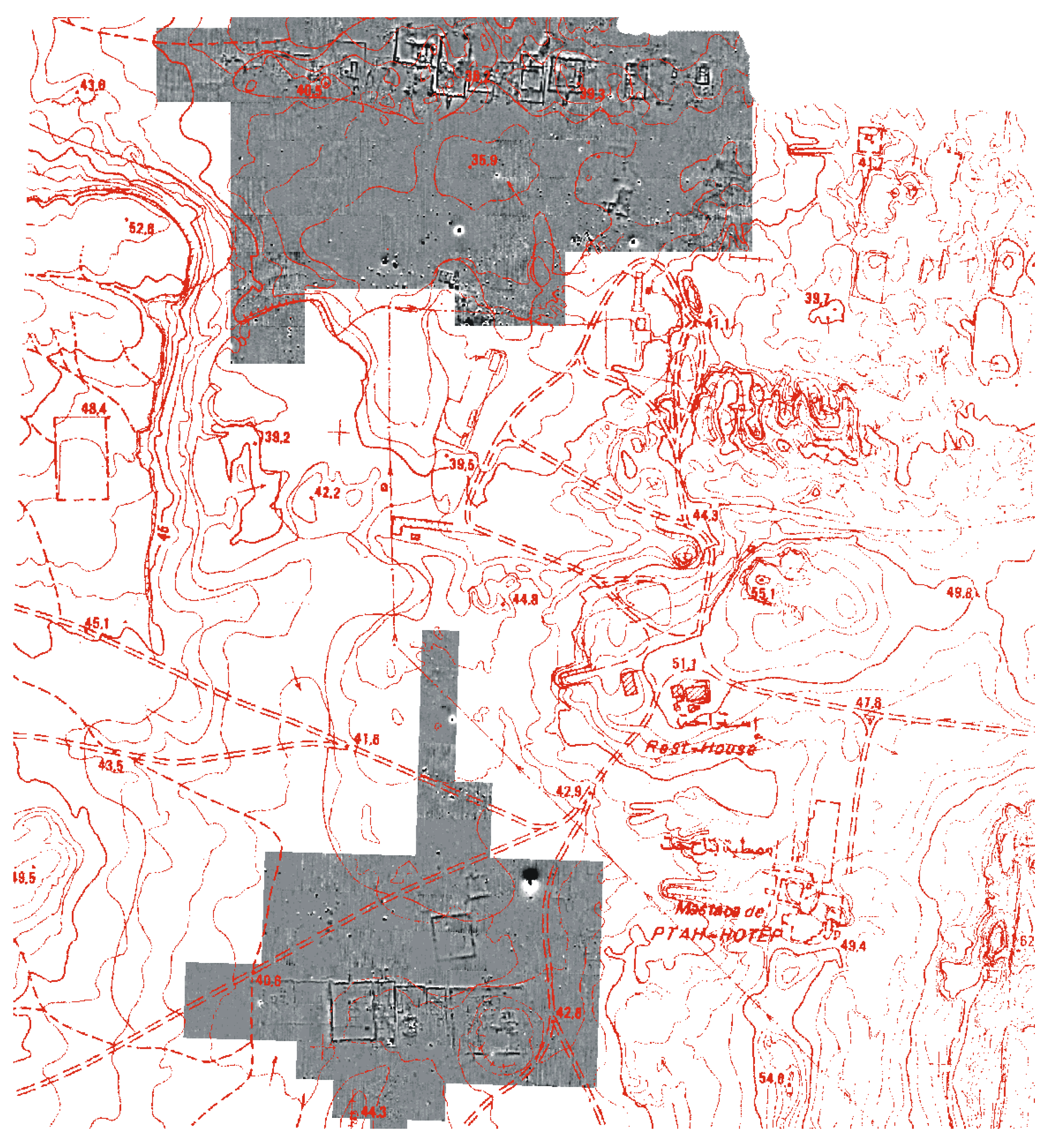The Legacy of Prince Khaemwaset at Saqqara
Abstract
:1. Introduction
2. Princely Precedents
‘[(And so) it happened that Nanefe]rka[ptah] my brother [had no] occupation in the land aside from hiking over the necropolis of Memphis, as he recited the writings that were in the tombs of the pharaohs, along with the stelas of the scribes of the House of Life, as well as the writings that were on [their tombs. How] very much [he rejoice]˹d˺(??) because of writing!’ [5].(p. 114)
3. Mobilising the Monumental Past
‘so greatly did he love antiquity (pAwt) and the noble ones who came before (Spsw imyw-HAt)’ [6].(pp. 471–472)
4. Geophysical Results and ‘Labelling’ Monuments
‘His Majesty decreed an announcement; It is the High Priest (of Ptah), the Sem-priest, King’s Son Khaemwaset, who has perpetuated the name of King [Unas]. Now his name was not found on the face of his pyramid. Very greatly did the Sem-priest, King’s Son Khaemwaset, desire to restore the monuments of the Kings of Upper and Lower Egypt, because of what they had done, the strength of which was falling into decay. He set forth a decree for its sacred offerings,… its water … [endowed] with a grant of land, together with its personnel…’.(writer’s translation)
…nTrw xprw Xr-HAt Htp m mr=sn saHw Axw m-mitt qrs m mr=sn qd Hwt nn-wn st...
…the gods who existed before rest in their tombs, the effective ancestors likewise buried in their tombs; the chapel-builders, (their?) places do not exist…
5. Iconography of the Iunmutef
6. Posthumous Legacy
7. Summary and Conclusions
Funding
Institutional Review Board Statement
Informed Consent Statement
Data Availability Statement
Acknowledgments
Conflicts of Interest
References
- Gomaà, F. Chaemwese Sohn Ramses’ II. und Hoherpriester von Memphis; Harrassowitz: Wiesbaden, Germany, 1973. [Google Scholar]
- Charron, A.; Barbotin, C. (Eds.) Khâemouaset, Le Prince Archéologue: Savoir ET Pouvoir à L’éPoque de Ramsès Ii. Musée Départemental; Arles Antique: Arles, France, 2016. [Google Scholar]
- Ray, J. Reflections of Osiris: Lives from Ancient Egypt; Profile Books: London, UK, 2001. [Google Scholar]
- Sourouzian, H. Recherches Sur la Statuaire Royale de la Xixe Dynastie; Institut Français D’archéologie Orientale: Cairo, Egypt, 2020. [Google Scholar]
- Vinson, S. The Craft of a Good Scribe: History, Narrative and Meaning in the First Tale of Setne Khaemwas; Brill: Leiden, The Netherlands; Boston, MA, USA, 2018. [Google Scholar]
- Snape, S. Khaemwese and the present past: History and the individual in Ramesside Egypt. In Ramesside Studies in Honour of K. A. Kitchen; Collier, M., Snape, S., Eds.; Rutherford: Bolton, UK, 2011; pp. 465–473. [Google Scholar]
- Snape, S. Some Ramesside Appropriations of Ancient Memphis. In Egypt 2015: Perspectives of Research, Proceedings of the Seventh European Conference of Egyptologists, Zagreb, Croatia; Popielska-Grzybowska, J., Tomorad, M., Eds.; Archaeopress: Oxford, UK, 2017; pp. 187–196. [Google Scholar]
- Porter, B.; Moss, R. Topographical Bibliography of Ancient Egyptian Hieroglyphic Texts, Reliefs and Paintings III2: Memphis. Part 2: Ṣaqqâra to Dahshûr, 2nd ed.; Oxford University Press: Oxford, UK, 1981. [Google Scholar]
- Collombert, P. La “formule de Khâemouaset”. In Questionner Le Sphinx: Mélanges Offerts à Christiane Zivie-Coche 1; Collombert, P., Laurent, C., Guermeur, I., Thiers, C., Eds.; Institut Français D’archéologie Orientale: Cairo, Egypt, 2021; pp. 231–292. [Google Scholar]
- Yoshimura, S.; Takamiya, I. Waseda University excavations at North Saqqara 1991–1999. In Abusir and Saqqara in the Year 2000; Bárta, M., Krejčí, J., Eds.; Academy of Sciences of the Czech Republic, Oriental Institute: Prague, Czech Republic, 2000; pp. 161–172. [Google Scholar]
- Yoshimura, S.; Kawai, N. An Enigmatic Rock-cut Chamber: Recent Waseda University Finds at North Sakkara. KMT Mod. J. Anc. Egypt 2002, 13, 22–29. [Google Scholar]
- Yoshimura, S.; Saito, M. Waseda University Excavations in Egypt and Recent Works at North Saqqara. In Egyptology at the Dawn of the Twenty-First Century; Hawass, Z., Ed.; American University in Cairo Press: Cairo, Egypt, 2003; Volume 1, pp. 574–581. [Google Scholar]
- Navrátilová, H. The Visitors’ Graffiti of Dynasties XVIII and XIX in Abusir and Northern Saqqara; Czech Institute of Egyptology: Prague, Czech Republic, 2007. [Google Scholar]
- Maystre, C. Les Grands Prêtres de Ptah de Memphis; Universitätsverlag, Vandenhoeck Ruprecht: Freiburg, Switzerland; Göttingen, Germany, 1992. [Google Scholar]
- Legrain, G. Répertoire Généalogique ET Onomastique du Musée du Caire. Monuments de la XVIIe ET de la XVIIIe Dynastie; Société anonyme des arts graphiques: Geneva, Switzerland, 1908. [Google Scholar]
- Karnak Cachette Database no. 773 (K 759). Available online: https://www.ifao.egnet.net/bases/cachette/ck773 (accessed on 8 June 2022).
- Hassan, S. The Sphinx: Its History in the Light of Recent Excavations; Government Press: Cairo, Egypt, 1949. [Google Scholar]
- Allen, J. A Monument of Khaemwaset honoring Imhotep. In Gold of Praise: Studies on Ancient Egypt in Honor of Edward F. Wente; Teeter, E., Larson, J.A., Eds.; Oriental Institute: Chicago, IL, USA, 1994; pp. 1–10. [Google Scholar]
- Zivie, C. Giza au Deuxième Millénaire; Institut Français d’Archéologie Orientale du Caire: Cairo, Egypt, 1976. [Google Scholar]
- Colonna, A. Religious Practice and Cultural Construction of Animal Worship in Egypt from the Early Dynastic to the New Kingdom: Ritual Forms, Material Display, Historical Development; Archeopress: Oxford, UK, 2021. [Google Scholar]
- Dodson, A. Bull cults. In Divine Creatures; Ikram, S., Ed.; American University in Cairo Press: Cairo, Egypt, 2005; pp. 72–105. [Google Scholar]
- Bovot, J.-L. Les Serviteurs Funéraires Royaux et Princiers de l’Ancienne Égypte; Réunion des Musées Nationaux: Paris, France, 2003. [Google Scholar]
- Pumpenmeier, F. Eine Gunstgabe von Seiten Des Königs: Ein Extrasepulkrales Schabtidepot Qen-Amuns in Abydos; Heidelberger Orientverlag: Heidelberg, Germany, 1998. [Google Scholar]
- Petrie, W.M.F. Gizeh and Rifeh; British School of Archaeology in Egypt, Bernard Quaritch: London, UK, 1907. [Google Scholar]
- Petrie, W.M.F. Seventy Years in Archaeology; Low, Marston: London, UK, 1931. [Google Scholar]
- Janes, G. The Amasis Collection; Olicar House: Lymm, UK, 2020. [Google Scholar]
- Abd el-Razik, M. The dedicatory and building texts of Ramesses II in Luxor temple. I: The texts. J. Egypt. Archaeol. 1974, 60, 142–160. [Google Scholar] [CrossRef]
- Bahrani, Z. The Infinite Image. Art, Time and the Aesthetic Dimension in Antiquity; Reaktion: London, UK, 2014. [Google Scholar]
- Price, C. A perfect “likeness”? Viewing Late Period archaising sculpture in context. In Statues in Context: Production, Meaning and (re)Uses; Masson-Berghoff, M., Ed.; Peeters: Leuven, Belgium, 2019; pp. 21–33. [Google Scholar]
- Ziegler, C. Réunis pour l’éternité: Les vases canopes du prêtre embaumeur Ty. In Studies in Honor of Ali Radwan 2; Daoud, K., Bedier, S., Abd El-Fattah, S., Eds.; Supreme Council of Antiquities: Cairo, Egypt, 2005; pp. 399–407. [Google Scholar]
- Delvaux, L. Donné en Récompense de la Part du roi (djw m Hswt nt xr nsw). Ph.D. thesis, University of Strasbourg, Strasbourg, France, 2008.
- Price, C. “His Image as Perfect as the Ancestors”: On the transmission of forms in First Millennium BC non-royal sculpture. In (Re)Productive Traditions in Ancient Egypt; Gillen, T., Ed.; Presses Universitaires de Liège: Liège, Belgium, 2017; pp. 395–410. [Google Scholar]
- Mathieson, I.; Dittmer, J. The geophysical survey of North Saqqara, 2001–7. J. Egypt. Archaeol. 2007, 93, 79–93. [Google Scholar] [CrossRef]
- Liritzis, I.; Laskaris, N.; Vafiadou, A.; Karapanagiotis, I.; Volonakis, P.; Papageorgopoulou, C.; Bratitsi, M. Archaeometry: An overview. Sci. Cult. 2020, 6, 49–98. [Google Scholar] [CrossRef]
- Fidan, E. Geo-archaeological and geophysical investigation of the Early Bronze Age Layers of Tavşanli Höyük (Inland Western Anatolia). Mediterr. Archaeol. Archaeom. 2021, 21, 211–225. [Google Scholar] [CrossRef]
- Taha, A.I.; El-Qady, G.; Metwaly, M.A.; Massoud, U. Geophysical investigation at Tell el-Dabaa ‘Avaris’ archaeological site. Mediterr. Archaeol. Archaeom. 2011, 11, 51–58. [Google Scholar]
- Martin, G.T. The Memphite Tomb of Ḥoremḥeb, Commander-In-Chief of Tut’ankhamūn, I: The Reliefs, Inscriptions, and Commentary; Egypt Exploration Society: London, UK, 1989. [Google Scholar]
- Martin, G.T. The Hidden Tombs of Memphis: New Discoveries from the Time of Tutankhamun and Ramesses the Great; Thames and Hudson: London, UK, 1991. [Google Scholar]
- Tawfik, S. Recently excavated ramesside tombs at Saqqara. 1: Architecture. Mitt. Dtsch. Archäologischen Inst. Abt. Kairo 1991, 47, 403–409. [Google Scholar]
- Tawfik, T.S. The extent of the New Kingdom cemetery in the Memphite necropolis. In Egyptology at the Dawn of the Twenty-first Century; Hawass, Z., Ed.; American University in Cairo Press: Cairo, Egypt, 2003; Volume 1, pp. 514–521. [Google Scholar]
- Drioton, E.; Lauer, J.-P. Une inscription de Khamouas sur la face sud de la pyramide d’Ounas à Saqqarah. Ann. Serv. Antiq. L’égypte 1937, 37, 201–211. [Google Scholar]
- Leclant, J. Le Prince Archéologue, Energies. Le Mag. Int. De Total 1993, 16, 39–41. [Google Scholar]
- Oppenheim, A.; Allen, J.P. The Inscription of Prince Khaemwaset. In the Pyramid Complex of Senwosret III at Dahshur. Architectural Studies; Arnold, D., Ed.; Metropolitan Museum of Art: New York, NY, USA, 2002; pp. 29–30. [Google Scholar]
- Siculus, D. Library of History, Volume I: Books 1-2.34; Translated by C. H. Oldfather; Loeb: London, UK, 1989. [Google Scholar]
- Herodotus. The Histories; Rawlinson, G., Ed.; David Campbell: London, UK, 1997. [Google Scholar]
- Colla, E. Conflicted Antiquities: Egyptology, Egyptomania, Egyptian Modernity; Duke University Press: Durham, NC, USA, 2007. [Google Scholar]
- Lane, E.W. Description of Egypt. Notes and Views in Egypt and Nubia, 1825–1828; Edited and with an Introduction by Jason Thompson; American University in Cairo Press: Cairo, Egypt, 2019. [Google Scholar]
- El-Daly, O. Egyptology. The Missing Millennium; Routledge: London, UK, 2005. [Google Scholar]
- Norden, F. Travels in Egypt and Nubia; Lockyer Davis and Charles Reymers: London, UK, 1757. [Google Scholar]
- Navrátilová, H. Khaemwaset in Dahshur: The prince and the stones. In Rich and Great: Studies in Honour of Anthony J. Spalinger on the Occasion of his 70th Feast of Thot; Landgráfová, R., Mynářová, J., Eds.; Charles University in Prague, Faculty of Arts: Prague, Czech Republic, 2016; pp. 259–266. [Google Scholar]
- Naville, E. The temple of Deir el Bahari, II.; Egypt Exploration Fund: London, UK, 1896. [Google Scholar]
- Malek, J. A meeting of the old and new. Saqqara during the New Kingdom. In Studies in Pharaonic Religion and Society in Honour of J. Gwyn Griffiths; Lloyd, A.B., Ed.; Egypt Exploration Society: London, UK, 1992; pp. 57–76. [Google Scholar]
- Goedicke, H. Re-Used Blocks from the Pyramid of Amenemhet I at Lisht; Metropolitan Museum of Art: New York, NY, USA, 1971. [Google Scholar]
- Twiston-Davies, H. The harpists’ songs at Saqqara: Transmission, performance, and contexts. In Perspectives on Lived Religion: Practices-Transmission-Landscape; Staring, N., Twiston-Davies, H., Weiss, L., Eds.; Sidestone Press: Leiden, The Netherlands, 2019; pp. 97–129. [Google Scholar]
- Kitchen, K. Pharaoh Triumphant: The life and Times of Ramesses II; Aris Phillips: Warminster, UK, 1982. [Google Scholar]
- Baines, J. Was the king of Egypt the sole qualified priest of the gods? In Questionner le sphinx: Mélanges Offerts à Christiane Zivie-Coche 1; Collombert, P., Coulon, L., Guermeur, I., Thiers, C., Eds.; Institut Français D’archéologie Orientale: Cairo, Egypt, 2021; pp. 73–97. [Google Scholar]
- Takamiya, I.H.; Kashiwagi, H.; Yoshimura, S. Khaemwaset and His Monument at North Saqqara: A Record of Multiple Aspects of ‘the First Egyptologist’. In Times, Signs and Pyramids. Studies in Honour of Miroslav Verner on the Occasion of His Seventieth birthday; Callender, V.G., Bareš, L., Bárta, M., Janák, J., Krejčí, J., Eds.; Faculty of Arts Charles University: Prague, Czech Republic, 2011; pp. 401–421. [Google Scholar]
- Bell, L. Luxor temple and the cult of the royal Ka. J. Near East. Stud. 1985, 44, 251–294. [Google Scholar] [CrossRef]
- Price, C. Ramesses, ‘King of Kings’: On the context and interpretation of royal colossi. In Ramesside Studies in Honour of K. A. Kitchen; Collier, M., Steven, S., Eds.; Rutherford: Bolton, UK, 2011; pp. 403–411. [Google Scholar]
- El Naggar, S. Étude préliminaire d’un ciel voûté de l’hypogée de Bakenrenef (L.24) à Saqqara. Egitto E Vicino Oriente 1986, 9, 15–38. [Google Scholar]
- Bothmer, B. The Brussels-Brooklyn statue of Bakenrenef (Membra Dispersa VI). In B. v. Bothmer Egyptian Art: Selected Writings of Bernard V. Bothmer; Oxford University Press: New York, NY, USA, 2004; pp. 395–405. [Google Scholar]
- Leprohon, R. The Great Name: Ancient Egyptian Royal Titulary; Society of Biblical Literature: Atlanta, GA, USA, 2013. [Google Scholar]
- Jurman, C. Legitimisation through Innovative Tradition—Perspectives on the Use of Old Models in Royal and Private Monuments during the Third Intermediate Period. In 7. Symposium zur Königsideologie, Proceedings of the seventh Symposium on Egyptian Royal Ideology: Royal versus Divine Authority: Acquisition, Legitimization and Renewal of Power, Prague, The Czech Republic, 26–28 June 2013; Coppens, F., Janák, J., Vymazalová, H., Eds.; Harrassowitz: Wiesbaden, Germany; pp. 177–214.
- Leahy, A. A battered statue of Shedsunefertem, high priest of Memphis (BM EA 25). J. Egypt. Archaeol. 2006, 92, 169–184. [Google Scholar] [CrossRef]
- Borchardt, L. Catalogue Général des Antiquités Égyptiennes du Musée du Caire. Statuen und Statuetten von Königen und Privatleuten im Museum von Kairo IV; Reichsdruckerei: Berlin, Germany, 1934. [Google Scholar]
- Dieleman, J. Priests, Tongues, and Rites: The London-Leiden Magical Manuscripts and Translation in Egyptian Ritual (100–300 CE); Brill: Leiden, The Netherlands, 2005. [Google Scholar]
- Myśliwiec, K. Le Portrait Royal Dans le Bas-Relief du Nouvel Empire; Éditions Scientifiques de Pologne: Warsaw, Poland, 1979. [Google Scholar]
- Fisher, M. The Sons of Ramesses II. Volume II: Catalogue; Harrassowitz: Wiesbaden, Germany, 2001. [Google Scholar]
- Kitchen, K.A. Ramesside Inscriptions. Historical and Biographical II; Blackwell: Oxford, UK, 1979. [Google Scholar]
- Kitchen, K.A. Ramesside Inscriptions. Translated and Annotated II; Blackwell: Oxford, UK, 1996. [Google Scholar]
- Bothmer, B. Egyptian Sculpture of the Late Period: 700 BC to AD 100, 2nd ed.; Brooklyn Museum: Brooklyn, NY, USA, 1969. [Google Scholar]
- Schwappach-Shirriff, L. Treasures of the Rosicrucian Egyptian Museum: A Catalogue; Rosicrucian Order, AMORC: San Jose, CA, USA, 2004. [Google Scholar]
- Quibell, J.E. Excavations at Saqqara (1907–1908); Institut Français D’archéologie Orientale: Cairo, Egypt, 1909. [Google Scholar]
- El-Khouly, A. Excavations East of the Serapeum at Saqqara. J. Egypt. Archaeol. 1973, 59, 151–155. [Google Scholar]
- McClain, B.J. The cosmogonical inscriptions of Ptolemy VIII Euergetes II and the cultic evolution of the temple of Djeser-set. In Perspectives on Ptolemaic Thebes: Papers from the Theban Workshop 2006; Dorman, P.F., Bryan, B.M., Eds.; The Oriental Institute of the University of Chicago: Chicago, IL, USA, 2011; pp. 69–96. [Google Scholar]
- Bianchi, R. Graeco-Roman uses and abuses of Ramesside traditions. In Fragments of a Shattered Visage: The Proceedings of the International Symposium of Ramesses the Great; Bleiberg, E., Freed, R., Eds.; Memphis State University: Memphis, TN, USA, 1991; pp. 1–8. [Google Scholar]
- Mariette, F.A. Le Sérapéum de Memphis par Auguste Mariette-Pacha; Publié D’àpres le Manuscript D’auteur par G. Maspero; F. Vieweg: Paris, France, 1882. [Google Scholar]
- Gallorini, C. Late Period and Ptolemaic pottery from the work of the Saqqara Geophysical Survey Project. In Proceedings of the Ninth International Congress of Egyptologists: Grenoble, 6–12 September 2004; Goyon, J.-C., Cardin, C., Eds.; Peeters: Leuven, Belgium, 2007; pp. 789–798. [Google Scholar]




| Location | Position | Attestation |
|---|---|---|
| Pyramid of Unas, Saqqara | South side | Survival |
| Mastaba of Shepseskaf, Saqqara | North side | Survival |
| Pyramid of Djoser, Saqqara | South side | Survival |
| Pyramid of Userkaf, Saqqara | East side | Survival |
| Temple of Niuserre Abu Ghurab | South side | Survival |
| Pyramid of Sahure, Abusir | ? | Survival |
| Pyramid of Pepi I, Saqqara | South side | Survival |
| Pyr. of Senwosret III, Dahshur | South side (?) | Survival |
| Pyramid of Menkaure (?), Giza | North side (?) | Reference |
| Pyramid of Khufu(?), Giza | ? | References |
| Pyr. of Amenemhat III, Hawara | ? | Reference |
Publisher’s Note: MDPI stays neutral with regard to jurisdictional claims in published maps and institutional affiliations. |
© 2022 by the author. Licensee MDPI, Basel, Switzerland. This article is an open access article distributed under the terms and conditions of the Creative Commons Attribution (CC BY) license (https://creativecommons.org/licenses/by/4.0/).
Share and Cite
Price, C. The Legacy of Prince Khaemwaset at Saqqara. Heritage 2022, 5, 2196-2209. https://doi.org/10.3390/heritage5030115
Price C. The Legacy of Prince Khaemwaset at Saqqara. Heritage. 2022; 5(3):2196-2209. https://doi.org/10.3390/heritage5030115
Chicago/Turabian StylePrice, Campbell. 2022. "The Legacy of Prince Khaemwaset at Saqqara" Heritage 5, no. 3: 2196-2209. https://doi.org/10.3390/heritage5030115
APA StylePrice, C. (2022). The Legacy of Prince Khaemwaset at Saqqara. Heritage, 5(3), 2196-2209. https://doi.org/10.3390/heritage5030115





